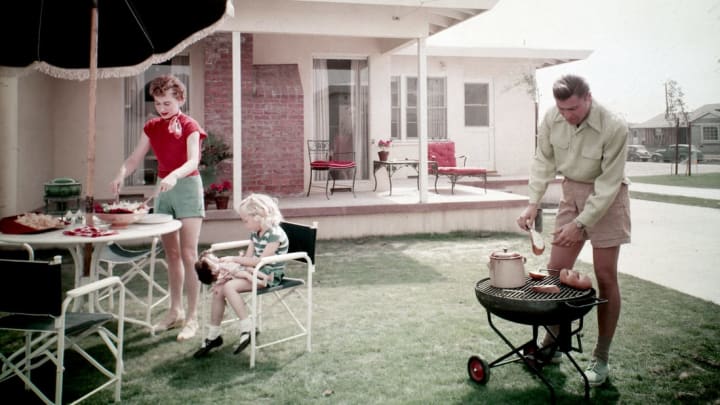Backyards are as American as apple pie and baseball. If you live in a suburban or rural area, chances are good that you have a lawn, and maybe a pool, some patio furniture, and a grill to boot.
This wasn’t always the case, though. As Smithsonian Insider reports, it wasn’t until the 1950s that Americans began to consider the backyard an extension of the home, as well as a space for recreation and relaxation. After World War II, Americans started leaving the big cities and moving to suburban homes that came equipped with private backyards. Then, after the 40-hour work week was implemented and wages started to increase, families started spending more money on patios, pools, and well-kept lawns, which became a “symbol of prosperity” in the 1950s, according to a new Smithsonian Institution exhibit.

Library in San Marino, California
Entitled "Patios, Pools, & the Invention of the American Back Yard," the exhibition includes photographs, advertisements, and articles about backyards from the 1950s and 1960s. The traveling display is currently on view at the Temple Railroad & Heritage Museum in Temple, Texas, and from there it will head to Hartford, Connecticut, in December.
Prior to the 1950s, outdoor yards were primarily workspaces, MLive.com reports. Some families may have had a vegetable garden, but most yards were used to store tools, livestock, and other basic necessities.
The rise of the backyard was largely fueled by materials that were already on hand, but hadn’t been accessible to the average American during World War II. As Smithsonian Insider notes, companies that had manufactured aluminum and concrete for wartime efforts later switched to swimming pools, patio furniture, and even grilling utensils.

At the same time, DIY projects started to come into fashion. According to an exhibit caption of a Popular Mechanics article from the 1950s, “‘Doing-it-yourself’ was advertised as an enjoyable and affordable way for families to individualize their suburban homes.” The magazine wrote at the time that “patios, eating areas, places for play and relaxation are transforming back yards throughout the nation.”
The American backyard continues to grow to this day. As Bloomberg notes, data shows that the average backyard grew three years in a row, from 2015 to 2017. The average home last year had 7048 square feet of outdoor space—plenty of room for a sizable Memorial Day cookout.
[h/t Smithsonian Insider]
